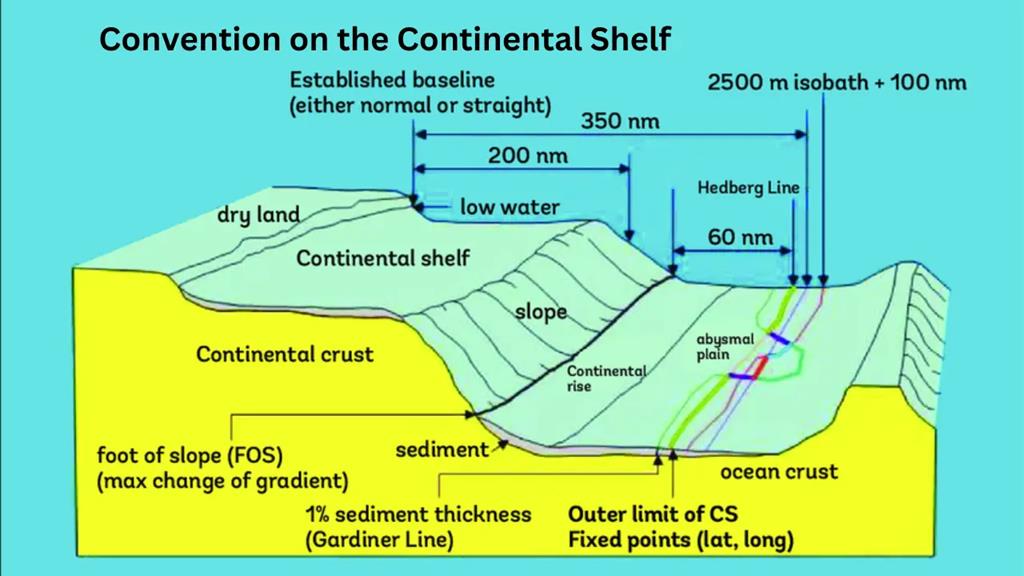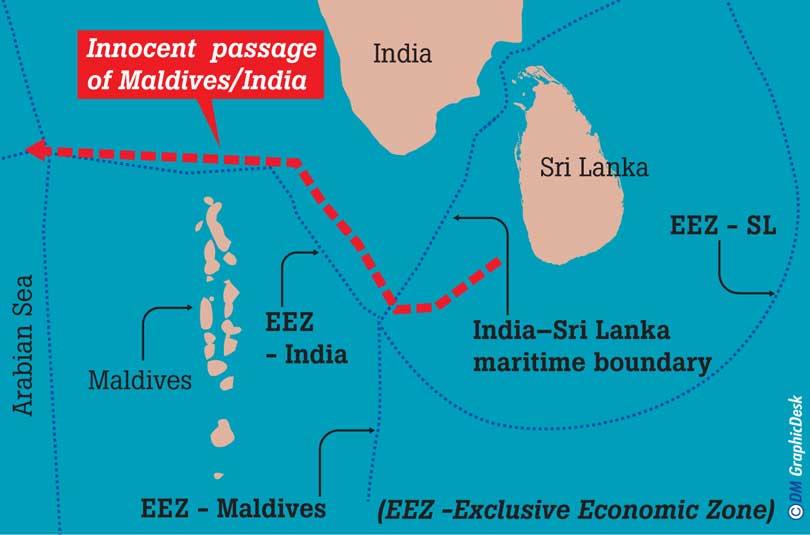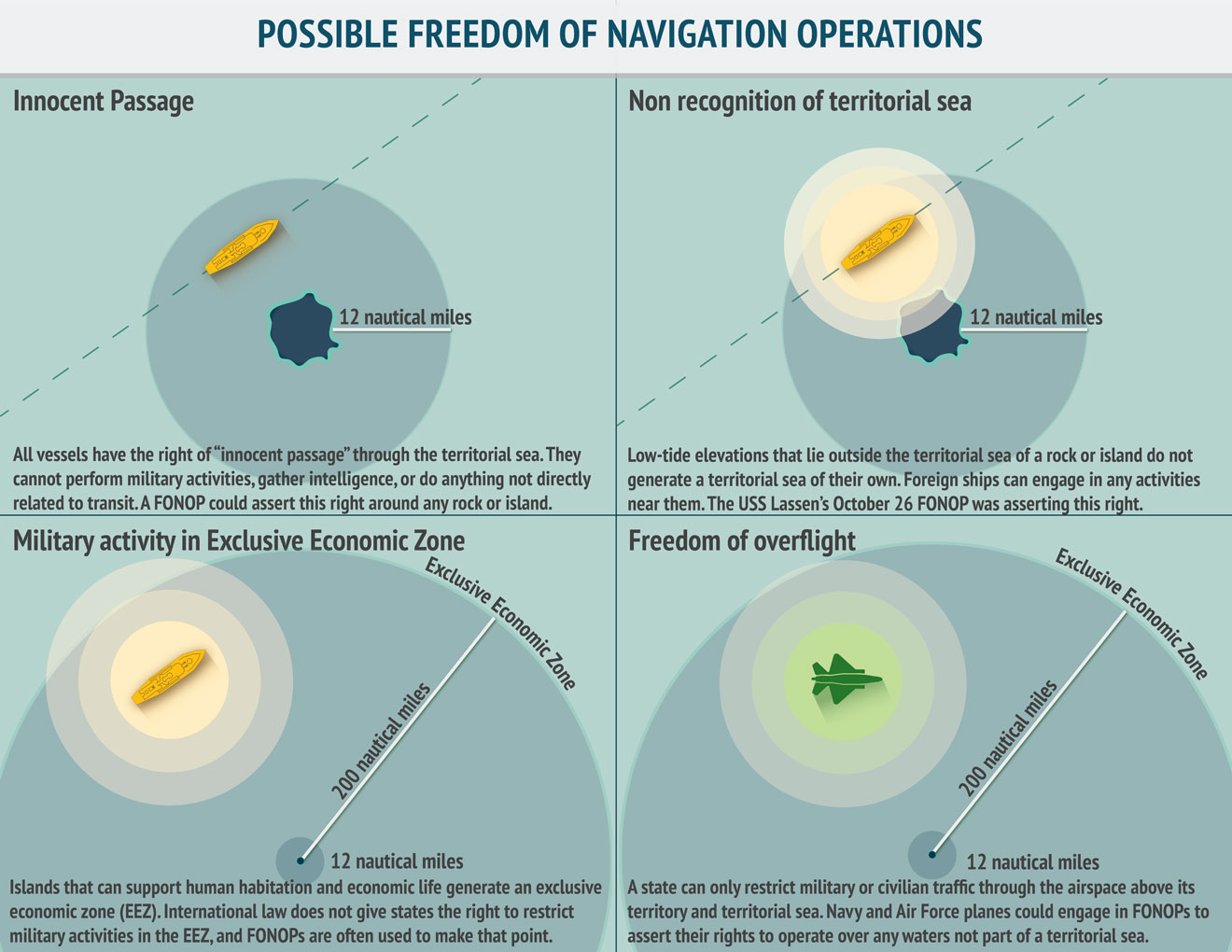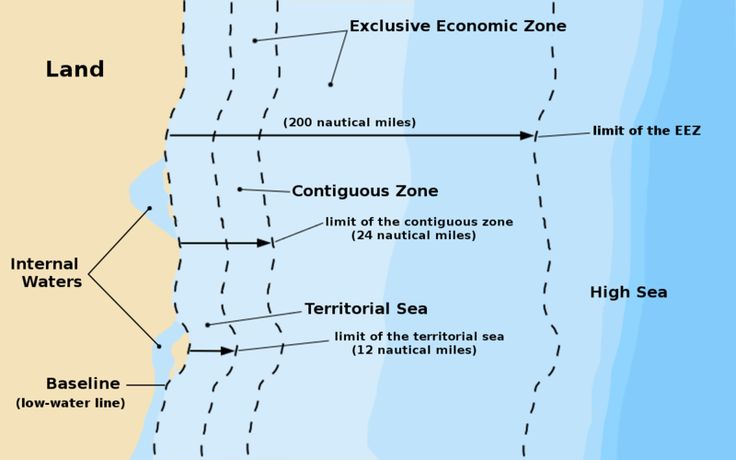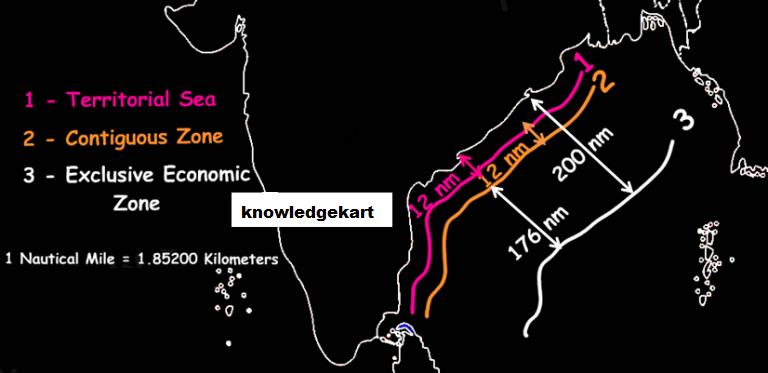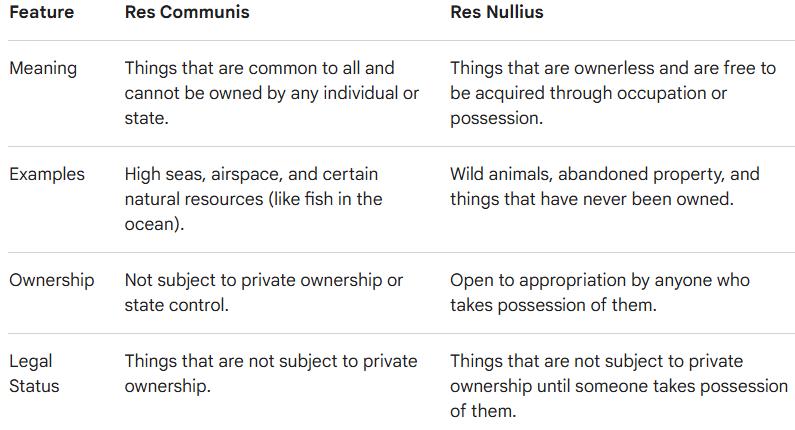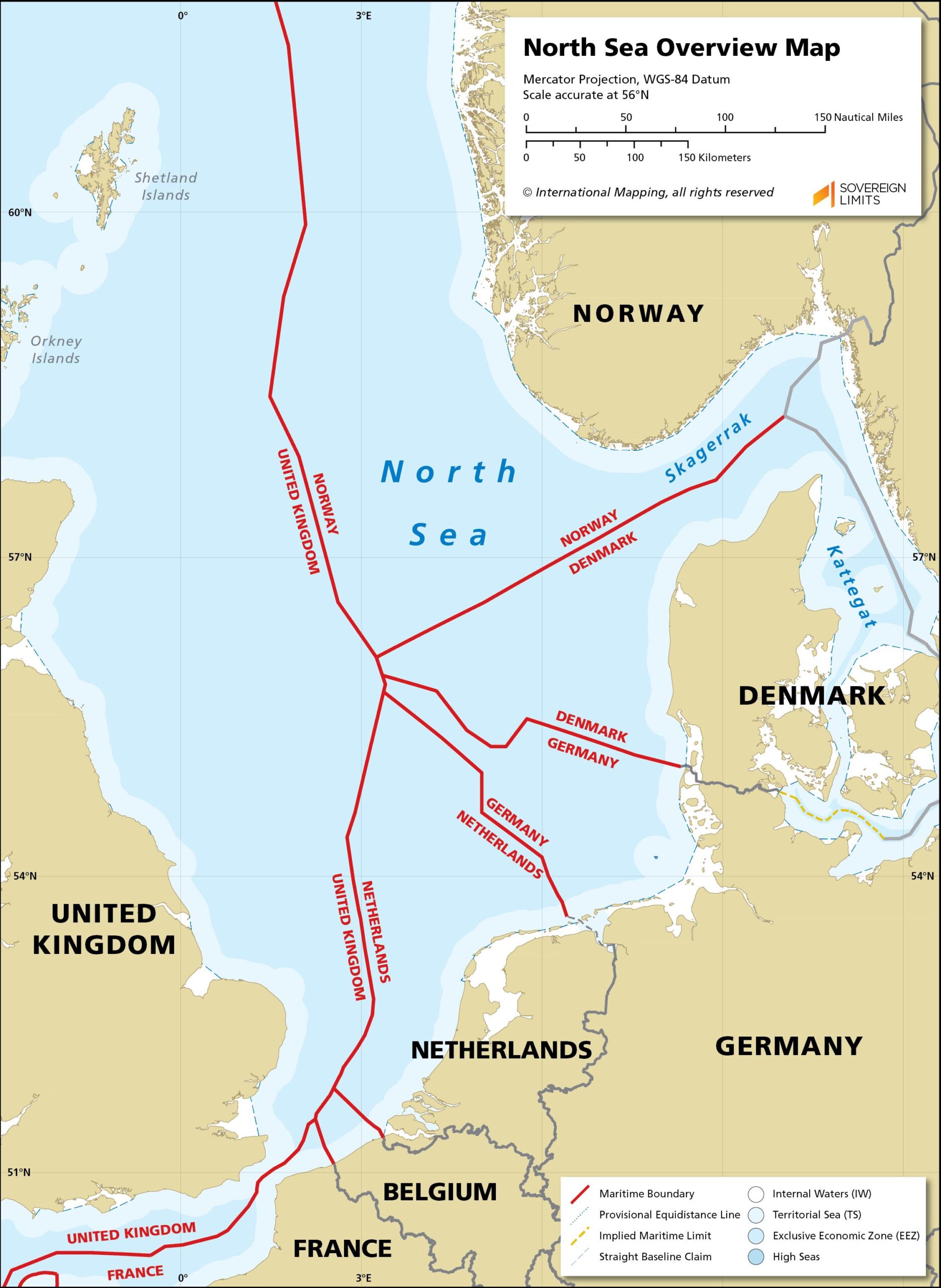Law of Sea
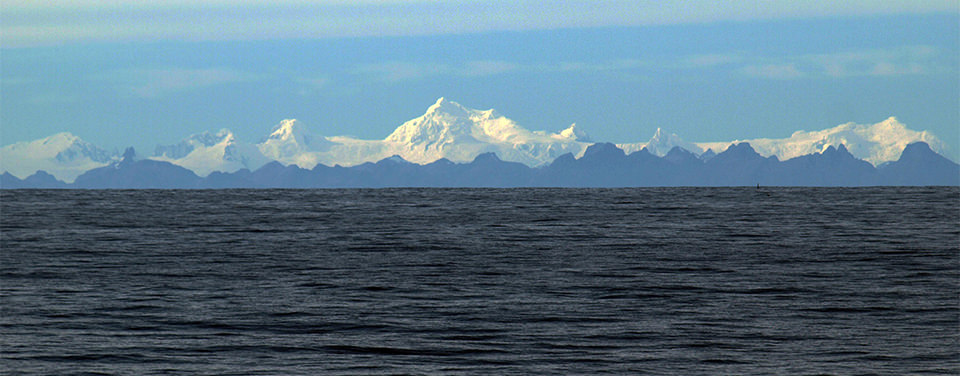
THANKS TO ALL INTELLECTUALS, FACULTIES, PUBLISHERS, WEBSITE CONTENT CREATORS, AND DR. S.K KAPOOR’s ‘INTERNATIONAL LAW & HUMAN RIGHTS”, 22ND EDITION BY CENTRAL LAW AGENCY, FROM WHOM AND WHERE CONCEIVED THIS CONTENT FOR EDUCATIONAL PURPOSE
LAW OF SEA
INTRODUCTION
- McDougal and Burke pointed that Law of Sea is an historic function
- To protect and balance common interests of all people in the use and enjoyment of the oceans and reject egocentric assertions of special interest
- Doctrine of “Freedom of the seas”
- Essentially non regulated and ‘laissez faire’
LAW OF SEA
- Territorial Sea
- Coastal state
- Innocent Passage
- Contiguous Zone
- Straits used for International Navigation
- Archipelagic Waters of an Archipelagic State
- Continental Shelf
- Exclusive Economic Zone or Patrimonial Sea
- High Seas
- Free and open to States
- Regime of Islands
- Enclosed or Semi-Enclosed Seas
- Rights of Access of Land-Locked States
- International Sea-Bed Area
- Protection and Preservation of Marine Environment
- Marine Scientific Research
- Settlement of Disputes
DEVELOPMENT OF THE LAW OF THE SEA
- Due to rise in the uses of sea, resulted in conflicts between the wider claims of Coastal States – to protect their economic interests
- UN Conferences on the Law of the Sea – Geneva (1958 & 1960)
- Geneva Conference on the Law of the Sea, 1958 (First Conference)
- Convention on the Territorial Sea and Contiguous Zone
- Convention on the High Seas
- Convention on Fishing and Conservation of Living Resources
- Convention on the Continental Shelf
- Geneva Conference on the Law of the Sea, 1960 (Second)
- To fix breadth of the Territorial Sea and it could not achieve success
- Certain developments followed the two UN Conferences are:
- There are large number of new States, mostly in Asia and Africa emerged
- Similarly rapid progress in Science and Technology made possible commercial exploitation of minerals and other resources at greater depths of seabed. Manganese nodules is one of the most valuable resources found
- Unprecedented growth in population and demands for higher living standards resulted in demands for food, fuel and other resources
- Principal components of polymetallic manganese nodules are vital for industries and hence few industrialized nations acquire them from developing nations
- Arvid Pardo of Malta was the first to raise to reserve seabed for peace
- UN General Assembly established an Ad Hoc U.N Seabed Committee to study the scope and various aspects requested by Maltese Ambassador
- UN General Assembly adopted “Declaration of Principles Governing the Seabed and Ocean-floor, and the Subsoil” in 17.12.1970
- Third UN Conference on the Law of the Sea (UNCLOS), 1973 held in New York and it was held in ten sessions from 1973 to 1982
- America actively participated up to 9th session and in the 10th session America proposed many amendments even to already agreed provisions and a group of 77 countries rejected the amendments
- 119 States including Soviet Union finally agreed and signed the Convention on the Law of the Sea on 10.12.1982 at Mantego Bay, Jamaica
- 22 States including America, Britain, West Germany, Italy, Belgium and Japan did not sign the convention
U.N CONVENTION ON THE LAW OF THE SEA (UNCLOS)
- It contains 320 Articles in XVII Parts and IX Annexes
- 159 delegations had recorded their participation
- Article 308 stated that the Convention shall enter into force 12 months after the date of deposit of the 60th instrument of ratification or accession
- Once the Convention, enters in to force
- Permanent Machinery
- International Sea Bed Authority
- International Tribunal for the Law of the Sea
- Will be established
- 159 States signed the Convention by 01.11.1988
- The Convention obtained 60 ratifications or accessions with the ratification by Guyana on 16.11.1993 and hence came in to force from 16.11.1994
- But some important states like U.S, U.K, Belgium, France, FR of Germany, Italy, Japan and Netherlands concluded Provisional undertaking and it was termed as Mini-treaty
- UN General Assembly, vide resolution 43/18, called on states to consider ratifying or acceding – 1982 UN CLOS
- 168 Countries have ratified the CLOS as of 28.01.2020
- a Mini-treaty is a violative of the Article 137(3) of the UNCLOS, 1982
- Preparatory Committee rejected such claim (anything which is incompatible), agreement or action as a basis for creating legal rights and regards it as wholly illegal
- India ratified the convention on 29.06.1996
- As on date, 167 Countries and European Community have become parties to the CLOS
- 19 countries have signed and not yet the ratified the CLOS which includes USA, UAE etc.,
MARITIME BELT or TERRITORIAL WATERS
- Belt of the Sea which is adjacent to the coastal State and over which the coastal State exercises the Sovereignty (Article 2)
- Coastal State exercises sovereignty over
- Territorial Waters
- Air Space over
- the Territorial Waters
- Its Beds
- Sub-soil
- Article 2(3) of the UNCLOS, 1982 states that ‘the sovereignty over the territorial waters is exercised subject to the convention and other rules of international law
BREADTH OF TERRITORIAL WATERS AND ASSOCIATED DISPUTES
- Maritime belt is that part of the sea over which the coastal States exercise sovereignty
- There was a great controversy in the limit of breadth of the maritime belt under International Law for a considerable period of time
- According to Jurist Bynkershoek, the breadth of the maritime belts extends to that distance where a cannon can fire.
- Up to 18th century, the range of cannon shot was 3 miles. It is called as Cannon shot rule.
- According to Jurist Grotius, the sovereignty of the coastal State should extend only to that area up to which it can exercise effective control was subscribed by another Jurist Vattel
- League of Nations attempted to fix the breadth in The Hague Conference 1930 which was an unsuccessful attempts
- UN Conferences in 1958 and 1960 tried to solve this issue.
- ICJ in the Anglo-Narwegian Fisheries case 1951 observed ‘The delimitation of the sea areas has always an international aspect rather than its municipal law’
- The adoption of UNCLOS 1982 ended this controversy relating to breadth of territorial sea
- Article 3 of the Convention provides that every state has the right to establish the breadth of its territorial sea up to a limit not exceeding 12 nautical miles measured from base lines determined in accordance with this convention
RIGHTS AND DUTIES OF COASTAL STATE
- Coastal State has complete sovereignty over its maritime belt
- This sovereignty extends to
- Waters of the Sea
- Over Air Space and seabed
- Subsoil of the Sea (Article 2(3))
- When two coastal states are adjacent to each other, the maritime shall be delimited on the median line to be measured from the base-line from which the width of maritime belt is measured (Article 15)
- Coastal State exercises penal jurisdiction
- Any state whether Coastal or not can exercise the right of innocent passage of its ships over maritime belt
- Article 18 of the convention provides that innocent passage means, to travel without availing facilities of internal waters or port or to reach internal waters or port and to avail the facilities thereof and the passage must be continuous and immediate
- Coastal State can make laws for the use of maritime belt by foreign ships
DELIMITATION OF TERRITORIAL SEA BETWEEN STATES WITH OPPOSITE OR ADJACENT COASTS
- Article 15 of the UN CLOS 1982 provides for delimitation of Territorial Sea
- When two states are opposite or adjacent to each other, if there is no prior agreement, no state is entitled to extend its territorial sea beyond median line which is equidistant from the nearest point on the baselines from which the breadth of the territorial seas of each of the two states is to be measured
- CASE LAW: Concerning Maritime Delimitation and Territorial Questions between Qatar and Bahrain (EQUIDISTANCE/SPECIAL CIRCUMSTANCES-Qatar argued for Mainland to Mainland method. On the other hand, Bahrain contended that it is a de facto archipelago or multiple-island state)
- The ICJ concluded that Bahrain is not entitled to apply the method of straight baselines. Each maritime feature has its own effect for the determination of the baselines on the grounds set out before, the low tide elevations situated in the overlapping zone of territorial seas will be disregarded.
INDIAN POSITION ON TERRITORIAL SEA
- India recognized 3 miles of territorial waters up to 1956
- It was extended to 6 miles by Presidential Proclamation in the same year
- In 1967, it was extended to 12 miles
- 40th Constitutional Amendment in 1976 through Article 297 provides ‘all lands, minerals and other things of value underlying the ocean within the territorial waters, or the continental shelf, or the exclusive economic zone of India shall vest in the Union and be held for the purposes of the Union
- India passed the Territorial Waters, Continental Shelf, Exclusive, Economic Zone and other Maritime Zones Act 1976
- Section 3 (2) of the act provides that ‘the limit of the territorial waters is the line every point of which is at a distance of twelve nautical miles from the nearest point of the appropriate base line.
- India’s position corresponds to the rule adopted in the UNCLOS 1982 and India signed in 1982
INNOCENT PASSAGE
- First UN Conference 1958 held at Geneva failed to fix a definite breadth of territorial waters but however laid certain important principles
- The convention made it clear that Coastal States exercise Sovereignty subject to certain exceptions
- Ships of other States are entitled to get passage through this part of sea i.e, Coastal States to provide innocent passage to ships of other States
- CASE LAW: CORFU CHANNEL CASE, 1949 (the ICJ ruled that during peace time the warships of the other States may pass through the territorial waters of a State. In this case the ICJ ruled Albania was guilty of causing loss to the British Ships by firing at them or otherwise by laying mines in that part of the sea)
- It is a well-recognized principle of customary International Law that foreign merchant vessels have a right of innocent passage through the territorial waters
- Articles 14 to 23 provides for the right of innocent passage
INDIAN POSITION ON INNOCENT PASSAGE
- Article 4 of the Territorial Waters, Continental Shelf, Exclusive Economic Zone and other Maritime Zones Act 1976 provides for the use of territorial waters by foreign ships
- It provides without prejudice to all foreign ships, other than Warships including submarines and other under water vehicles shall enjoy the right of innocent passage through the territorial waters
- Foreign warships including submarines and other underwater vehicles may enter or pass through the territorial waters after giving prior notice to the Central Government
- Those vehicles thus allowed shall navigate on the surface and show flag while passing through such waters
- Central Government may, if feel necessary, in the interests of peace, good order or security of India or any part thereof, suspend the entry of all or any class of foreign ships
CONTIGUOUS ZONE
- Contiguous zone is that part of the sea which is beyond and adjacent to the Territorial Sea of the coastal State
- Article 33 of the UN Convention on the Law of the Sea 1982 provides for Contiguous zone
- The Coastal State may exercise the control necessary to
- Prevent infringement of its customs, fiscal, immigration or sanitary regulations within its territory or territorial sea
- Punish infringement of the above regulations committed within its territory or territorial sea
- Contiguous Zone imposes certain restrictions on the freedom of High Seas
- Contiguous Zone may not extend beyond 24 nautical miles baseline from which the breadth of the territorial sea is measured
INDIAN POSITION
- India’s position in conformity with the provisions of UNCOL 1982
DISTINCTION BETWEEN MARITIME BELT AND CONTIGUOUS ZONE
| MARITIME BELT | CONTIGUOUS ZONE |
| Extends up to 12 nautical miles from the base line | Extends up to 24 nautical miles from the baseline |
| Coastal States have complete sovereignty Extends to Territorial Waters, Space over it, Seabed and sub-soil | It is subject to exceptions: innocent passage |
| Coastal States have penal jurisdiction over it | No penal jurisdiction |
| Subject to certain exceptions of innocent passage for foreign ships | Contiguous extends 12 nautical miles further from the maritime belt |
STRAITS USED FOR INTERNATIONAL NAVIGATION
- In Corfu Channel Case 1949, the International Court of Justice has held that states in time of peace have a right to send their ships through straits used for International navigation between two parts of the sea without the previous authorization of a coastal State provided that the passage is innocent
- Article 38 of the Convention provides that all ships and aircraft shall enjoy the right of transit passage, which shall not be impeded, except that, if the strait is formed by an island of a state bordering the strait and its mainland, transit passage shall not apply if there exists seaward of the island a route through the high seas or through an exclusive economic zone of similar convenience with respect to navigational and hydrographical characteristics
- Duties of Ships and aircraft during transit passage has been provided in the Article 39
ARCHIPELAGIC WATERS OF AN ARCHIPELAGIC STATE
- Article 46(a) of the UNCLOS provides for the meaning of ‘Archipelagic State’ as ‘a state constituted wholly by one or more archipelagos and may include other islands
- ‘Archipelago’ means a group of islands, including parts of islands, inter-connecting waters and other natural features which are so closely inter-related that such islands, waters and other natural features form an intrinsic geographical, economic and political entity or which historically have been regarded as such.
- An Archipelagic state may draw straight archipelagic baselines joining the outermost points of the outermost islands
- The length of such baselines shall not exceed 100 nautical miles
NATURE OF ARCHIPELAGIC WATERS AND DISTINCTION
- Archipelagic waters resemble internal waters and territorial waters, in certain other respects they are different from such waters
- Archipelagic waters resemble the territorial waters but are distinct from them because of the extensive control and limitation of this passage by the archipelagic state
- Right of Innocent passage in an archipelagic state is different from that of the territorial waters
- Right of Innocent passage in an archipelagic state is different in the following ways
- There is no express provision for the right of ships to stop and anchor where they are incidental or required by reasons of ‘force majeure’
- The right of the coastal state to designate sea lanes and prescribe traffic separation scheme means that foreign vessels have less freedom than in territorial sea
- The right of the coastal state in respect of warship that does not comply with its laws and regulations concerning passage extends beyond suspension and a request to leave the archipelago sea, to prohibiting the passage of such warships through its archipelagic sea for any length of time
CONTINENTAL SHELF
- Geographical and geological concept of Continental Shelf is old one
- UK Venezuela Treaty of 1942 was the first Legal Concept of Continental Shelf which deals with Gulf of Paria between UK and Venezuela
- However, Truman Proclamation of 1945 where US declared the resources of the Shelf contiguous to the US
- US State Department made a press release as ‘submarine land which is contiguous to the continent and which is covered by no more than 100 fathoms of water and thereby it rejected the concept of the Continental Shelf as res ominiam communis and also avoided its right on the concept as res nullis.
- Many countries encouraged by the US Proclamation made similar proclamations.
- Geneva Convention of Continental Shelf 1958 necessitated a definite shape and form and problems related to it.
- It defined
- “The Continental Shelf is
- (a) the sea-bed and sub-soil of the submarine areas adjacent to the coast, but outside the area of the territorial sea to a depth of 200 meters or beyond that limit to where the depth of superjacent waters admits of the exploitation of the natural resources of the said areas
- (b) to the sea-bed and sub-soil of similar submarine areas adjacent to the coast of the island
- The definition of Continental Shelf in Art. I of the Geneva Convention is ambiguous and inadequate
- This is due to the fact, due to lack of scientific development, it was not possible to explore and exploit beyond 200 meters by 1958
- Geneva Convention in other words defines Continental Shelf has three elements
- Adjacency
- Depth
- Exploitability
- But as according Juraj Andrassy who published in his ‘International Law and the Resources of the Sea’, Continental Shelf has the following five criteria
- Other limits of the shelf for geological purposes
- Pre-determined distance from the coast
- Pre-determined depth or isobath
- An exploitability test and
- An adjacency test
- “The Continental Shelf is
- CASE LAW: North Continental Shelf Cases 1969
[The International Court of Justice observed, “The rights of the coastal State in respect of the area of the Continental Shelf that constitutes of natural prolongation of its land territory into and under the sea exist ipso facto and ab initio by virtue of its sovereignty over the land, and as an extension of it in exercise of sovereign rights for the purpose of exploring the sea-bed and exploiting its natural resources” It is an inherent right.]
- In the 3rd UN Conference on the Law of the Sea, consensus has emerged in favor of natural prolongation theory.
- Article 76 of UN Convention defines Continental Shelf as comprising
- The sea-bed and sub-soil of the sub marine areas that extend beyond its territorial sea throughout the natural prolongation of its land territory to the outer edge of the continental margin, or to a distance of 200 nautical miles from the baselines from which the breadth of the Territorial Sea is measured where the outer edge of the continental margin does not extend up to that distance.
- Illustration: A State C’s exploration Ship discovers oil below the depth of 1500 metre in the Seabed at a distance of 190 miles from the Indian coast. India claims that She has exclusive rights to exploit and use this oil. Is India’s claim justified?
- India’s claim is justified because as for definition of continental shelf in Article 76 of the Law of the Convention 1982, the continental shelf of a coastal State extends to the edge continental margin or 200 nautical miles where the outer edge of the continental margin does not extend up to that distance.
DELIMITATION OF THE CONTINENTAL SHELF BETWEEN TWO OR MORE STATES
- Article 6(1) of the Geneva Continental Shelf Convention provides that where the Continental Shelf is adjacent to the territories of two or more States whose coasts are opposite to each other, the boundary of the Continental Shelf appertaining to such State shall be determined by agreement between them.
- If there is no agreement and/or any other boundary line is justified by special circumstances, the boundary is the median line, every point of which is equidistant from the nearest points of the baselines from which the breadth of the territorial sea is measured
- CASE LAW: North Sea Continental Shelf Cases 1969
[There existed Special Agreements between Kingdom of Denmark and the Federal Republic of Germany and between Federal Republic of Germany and the Kingdom of the Netherlands and hence the Continental Shelf shall be as per the Special Agreements on that behalf]
- Case Laws:
- North Sea Continental Shelf Cases 1969
- Tunisia – Libyan Arab Republic Continental Shelf Case 1982
- Canada-US Case concerning Delimitation of the Maritime Boundary 1984
- Libyan Arab Jamahiriya/Malta Continental Shelf Case 1985
INDIAN POSITION ON CONTINENTAL SHELF
- India is one of the signatories of the UNCLOS but she has not yet ratified it
EXCLUSIVE ECONOMIC ZONE OR PATRIMONIAL SEA
- The concept of economic zone or patrimonial sea was advocated by Kenya in the ASIAN AFRICAN LEGAL CONSULATIVE COMMITTEE at its Colombo Session in 1971
- Kenya submitted a final draft of exclusive economic zone concept to UN Sea-Bed Committee during the Geneva session in 1972
- Article 55 of the UN Convention on the Law of the Sea 1982 provides for Exclusive Economic Zone (EEZ)
- It states that “EEZ” is an area beyond and adjacent to the territorial sea, subject to the specific legal regime established in Part V, under which the rights and jurisdictions of the coastal State and freedoms of other States are government by the relevant provisions of this convention
- Article 56 deals with rights, jurisdictions and duties of a coastal State in the ‘EEZ’ and its excerpts are:
- Sovereign rights (Exploring & Exploiting)
- Natural Resources, Living or Non-Living (Conserving & Managing)
- Other Activities (w.r.t Economic Exploration and Exploitation)
- Artificial islands (establishment & use), installation and structures
- Marine scientific research
- Marine Environment (Protection & Preservation)
- Other rights and duties provided
- Article 57 provides that the Exclusive Economic Zone shall not exceed beyond 200 nautical miles from the baselines from which the breadth of the territorial sea is measured
- Article 73 deals with the “Enforcement of laws and regulations of the state” defines about Sovereign rights, release of arrested vessels and penalties for violations
- CASE LAW: M/V “Saiga Case (Saint Vincent and the Grenadines v. Guinea 1997)
[The case dealt with the arrest and detention of foreign vessels, action taken and of penalties imposed]
- In the exclusive economic Zone, all States, whether coastal or land-locked, enjoy, subject to the relevant provisions of this convention, the freedoms referred to Article 87
- of navigation and overflight and
- of the laying of submarine cables and pipelines and
- other internationally lawful use of the sea related to these freedoms such as those associated with
- the operation of ships, aircraft and
- submarine cables and pipelines and
- compatible with other provisions of this convention
- Article 88 to 115 (High Seas) and other pertinent rules of International Law apply to the exclusive economic zone
DISTINCTION BETWEEN EXCLUSIVE ECONOMIC ZONE AND CONTIGUOUS ZONE
| EXCLUSIVE ECONOMIC ZONE | CONTIGUOUS ZONE |
| Extends up to 200 nautical miles from the base line | Extends up to 24 nautical miles from the baseline |
| Coastal States have sovereign rights to explore and exploit, conserve natural resources and economic exploration and exploitation | It is subject to exceptions: innocent passage |
| Coastal States have penal jurisdiction over it | No penal jurisdiction |
| Extends 188 nautical miles further from the maritime belt
Jurisdiction of establishment and use of Artificial islands, installation and structures, marine scientific research and preservation and protection of marine environment |
Contiguous extends 12 nautical miles further from the maritime belt
Not applicable in the Contiguous zone |
DISTINCTION BETWEEN EXCLUSIVE ECONOMIC ZONE AND CONTINENTAL SHELF
- Concept of Economic zone is related to both exclusive Fisheries Zone and Continental Shelf
- Concept of exclusive Economic Zone differs both from the Continental Shelf and the exclusive Fisheries Zone
- It differs from the Continental Shelf that extends to the living and non-living resources in the area of the sea
- It differs from the exclusive Fisheries Zone in so far as it adopts an uniform approach to all resources – living and non-living
- The concept of exclusive Economic Zone highlighted by the 1982 Convention on the Law of the Sea has become “part of modern law”
- CASE LAW: Libyan Arab Jamahiriya/ Malta 1985 – Continental Shelf
[Although the institution of the Continental Shelf and the Exclusive Economic Zone are different and distinct, the rights which the exclusive economic zone entails over the sea-bed are defined by reference to the regime laid down for the continental shelf]
INDIAN POSITION ON EXCLUSIVE ECONOMIC ZONE
- Section 7 of the Territorial Waters, Continental Shelf, Exclusive Economic Zone and other Maritime Zones Act 1976 provides that the exclusive Economic Zone of India is an area beyond and adjacent to the territorial waters, and the limit of such Zone is 200 nautical miles from the baseline from where territorial waters are measured
- The Central Government, may whenever it considers necessary so to do having regard to International Law and State practice, alter by notification in the official Gazette, the limit of the exclusive Economic Zone
HIGH SEAS
- The concept of freedom of open sea or high seas is very old
- In the modern times it has assumed and added significance
- Geneva Convention on the High Seas was adopted in 1958
- Article 1 of the Convention defines High Seas as the parts of the sea that are not included in the territorial sea or in the internal waters of a State
- Recent developments, particularly the emergence of the concept of exclusive economic zone, this definition has become obsolete and inadequate
- Article 86 of the U.N Convention on the Law of the Sea, 1982 provides that the provisions of Part VII apply to all parts of the sea that are not included in the exclusive economic zone, in the territorial sea or in the internal waters of a State, or in the archipelagic waters of an archipelagic State
CONFLICT BETWEEN MARITIME SOVEREIGNTY AND FREEDOM OF HIGH SEAS
- In the ancient period, it was generally believed that high seas are a common heritage of mankind and are not within the property of any State
- In 1580, the reply of Queen Elizabeth to Spanish Ambassador remembered as an important event in regard to the freedom of High Seas
- In 1609, Grotius also expressed in the same tone, freedom of high seas
- The Convention on the high seas was adopted in 1958 and its preamble cleared that provisions were declaratory of customary law
- Many of the provisions were criticized and even challenged
- UN Convention on the Law of the Sea 1982 seeks to reconcile these claims and counter-claims of major maritime powers
- Article 87 of the Convention provided that high seas are open for all the States, whether coastal or land-locked
FREEDOMS OF HIGH SEAS
- Article 2 of the 1958, Geneva Convention on the high seas provides that the Freedom of the high seas comprises inter alia both coastal and non-coastal States:
- Freedom of Navigation
- Freedom of fishing
- Freedom to lay submarine cables and pipelines
- Freedom to fly over the high seas
- Freedoms enumerated are not exhaustive. However, no express provision of the freedom of scientific research and the freedom to construct Islands and other installations permitted under international law
- UN Convention on the Law of the Sea 1982 has included these two freedoms
- Article 87(1) expressly enumerates
- Freedom of navigation
- Freedom of overflight
- Freedom to lay submarine cables and pipelines
- Freedom to construct artificial islands and other installations permitted under international law
- Freedom of fishing and
- Freedom of scientific research
- Article 87(1) expressly enumerates
CRITICISM OF THE TRADITIONAL DOCTRINE OF THE FREEDOM OF THE SEAS
- The doctrine of the freedom of the high seas is a typical example of Eurocentric law
- It was devised and developed at a particular period of history to serve the needs and interests of the rich and powerful Industrial States of Western Europe and United States of America
- A Senator of USA remarked that under the freedom of the seas doctrine there is not much equity between developed and under-developed coastal nations and a less developed nation is a second-class citizen
- In the name of the freedom of the high seas the developed maritime countries have been using high seas for activities such as
- Naval military operations
- Dumping radioactive water
- Testing nuclear weapons and
- Sending submarines equipped with nuclear missiles near the coasts of other states
- The UN Convention on the Law of the Sea, 1982 has endeavored to achieve the synthesis between the exclusive claims of developing countries and inclusive claims of major maritime powers
JURISDICTION ON THE HIGH SEAS
- Article 91 of the UN Convention on the Law of the Sea, 1982 provides that it is the duty of every State to fix the conditions for the grant of its nationality to ships, for the registration of ships in its territory, and for the right to fly its flag
- Article 94 provides that “Every State shall effectively exercise its jurisdiction and control in administrative, technical and social matters over ships flying its flag
- Article 95 provides that Warships on high seas have complete immunity from the jurisdiction of any State other than flag State
- Article 96 provides that this immunity is only for State Owned or operated by State and used only on government non-commercial service
- The General rule is that the State whose flag ship is flying (and of course is entitled to fly) has complete jurisdiction over the ship and its crew subject to some exception
- One such exception is RIGHT OF VISIT
- Another exception is RIGHT OF HOT PURSUIT
CONSERVATION AND MANAGEMENT OF THE LIVING RESOURCES OF THE HIGH SEAS
- Freedom of High Seas is not an absolute principle i.e.; it does not mean freedom to pollute or over-exploit
- Section 2 of Part VII of the UN Convention on the Law of the Sea, 1982 provides for conservation and management of the Living Resources of the High Seas
- The Convention confers on the nationals of all States, the right to engage in fishing on the high seas subject to
- Their treaty obligations
- Rights and duties as well as the interests of the Coastal States
REGIME OF ISLANDS
- Article 121 of the UN Convention on the Law of the Sea provides for the Regime of Islands as
- A naturally formed area of land, surrounded by water, which is above water at high tide
- Except as provided for in paragraph 3, the territorial sea, the contiguous zone, the exclusive economic zone and the continental shelf of an island are determined in accordance with the provisions of the convention applicable to other land territory
- Rocks which cannot sustain human habitation or economic life of their own shall have no exclusive economic zone or continental shelf
ENCLOSED OR SEMI-ENCLOSED SEAS
- Article 122 provided that “Enclosed or semi-enclosed sea” means a gulf, basin, or sea surrounded by two or more states and connected to another sea or the ocean by a narrow outlet or consisting entirely or primarily of the territorial seas and exclusive economic zones of two or more coastal states. Article 123 mandates that States bordering an enclosed or semi-enclosed seas should co-operate with each other in the exercise of their rights and in the performance of their duties under the convention
RIGHT OF ACCESS OF LAND-LOCKED STATES TO AND FROM THE SEA AND FREEDOM OF TRANSIT
- Article 124 provides for Land-locked state and Transit state as ‘a state which has no sea-coast’ and ‘a state, with or without a sea-coast, situated between a land-locked state and the sea through whose territory traffic in transit passes’ respectively
- Article 125 provides for that
- Land-locked states shall have the right of access to and from the sea for the purpose of exercising the rights provided for in the convention, which included freedom of high seas and common heritage of mankind, and shall enjoy the freedom of transit by all means of transport
- Terms and modalities for exercising freedom of transit shall be agreed between the land-locked states and transit states concerned through bilateral, sub-regional or regional agreements
- Transit states, in the exercise of their full sovereignty over their territory, shall have the right to take all measures necessary to ensure that the rights and facilities provided for in Part X of the convention shall in no way infringe their legitimate interests
INTERNATIONAL SEA-BED AREA
- The first essential requirement of a legal regime of the International Sea-bed Area (hereinafter called the ‘Area’) is that the precise limits of the Area should be clearly defined and they should be delimited from other maritime zones
- The Area has been defined as the sea-bed and ocean floor and sub-soil thereof beyond the limits of national jurisdiction
- An effective and workable definition of the ‘Area’ is contingent upon a workable definition and agreement on the continental shelf.
- The UN Convention on the Law of the Sea, 1982 has removed the ambiguities of the earlier definition
- Article 76, paragraph 5 provides
- that the outer limit of the continental shelf shall not exceed 350 nautical miles from the baselines from which the breadth of the territorial sea is measured or
- shall not exceed 100 nautical miles from the 2500 metre isobath, which is a line connecting the depth of 2500 metres
- A great land mark in the development of law relating to the ‘Area’ was the adoption of the Declaration of Principles of International Law, Governing the Deep-Sea Floor (International Sea-bed Area) by the General Assembly in 1970 on the basis of the report of the UN Sea-bed Committee.
- The declaration contains 15 Principles like Area as common heritage of mankind, no claim, non-appropriation of the Area, Availability of area for peaceful purposes etc.,
- UN Convention on the Law of the Sea, 1982’s draft was adopted by a majority of 130 states. As of January 2015, 166 Countries and European Union have become parties to the U.N Convention on the Law of the Sea
- The developed and developing states took diametrically opposite positions with respect to System of Exploration and Exploitation of the resources, when the Third UN CLOS started negotiations.
INTERNATIONAL SEA-BED AUTHORITY
- Article 156 of the UN Convention on the Law of the Sea, 1982 provides for the establishment of the International Sea-bed Authority. All state parties to the Convention are ipso facto members of the Authority.
- The Authority is the organization which organize and control activities in the International Sea-bed Area with a view to administering the resources of the area
- The Authority is based on the principle of the sovereign equality of all its members
- Principal Organs of the Authority consist of
- The Assembly consists of all members of the Authority
- The Council which is the executive organ consist of 36 members elected by the Assembly
- Subsidiary organs of the Council are: Economic Planning Commission and Legal and Technical Commission
- The Secretariat
- Other Organs of the Authority are
- Enterprise
- Sea-bed Disputes Chamber of the International Tribunal for the Law
- International Tribunal for the Law of the Sea was established in 1996
- S and certain other Western Countries decided not to sign the Law of the Sea convention and its implications.
- Objection to the convention’s provisions relating to deep-seabed mining dealt mainly with the detailed procedures for production authorization from the deep sea-bed
- UN General Assembly in 1994 adopted the Agreement Relating to the Implementation of Part XI which removed the obstacles to Universal Participation
PROTECTION AND PRESERVATION OF MARINE ENVIRONMENT
- One of the main achievements of the 3rd UN Conference on the Law of the Sea is to adopt generally agreed provisions relating to protection and preservation of the marine environment
- These provisions will govern nearly three-furth of the surface of the earth
- Article 192 provides that States have the obligation to protect and preserve the marine environment
- Articles 207 to 212 provides for detailed International rules and national legislation to prevent, reduce and control pollution from land based sources, sea bed activities subject to national jurisdiction, activities in the area by dumping vessels from through the atmosphere
MARINE SCIENTIFIC RESEARCH
- Articles 238 to 278 provides that all States and competent international organizations have the right to conduct marine scientific research subject to the rights and duties of other States as provided under the Convention
SETTLEMENT OF DISPUTES
- Part XV of the convention provides for the Settlement o Disputes which is divided in to two parts namely (i) General Provisions and (ii) Compulsory Procedures Entailing Binding Decisions
- Article 279 imposes obligation upon State Parties to settle disputes by peaceful means
- Article 280 provides that State Parties may agree to settle a dispute concerning the interpretation or application of the Convention by any peaceful means of their own choice
- As regards to Compulsory Procedures Entailing Binding Decisions, the Convention has made ‘a significant departure from the traditional principle of International law under which a State has the sovereign right to refuse to submit a dispute to an independent body
- Article 287 of the Convention provides for the establishment of ‘The International Tribunal for the Law of the Sea in 1996
- Article 296 provides that any decision rendered by a court or tribunal having jurisdiction under Section 2 shall be final and shall be complied with by all the parties to the dispute
- Article 292 of the UN Convention on the Law of the Sea, 1982 deals with the prompt release of vessels and crews subject to conditions
- CASE LAW: The M/v. Saiga case 1997
[Agent of Saint Vincent and the Grenadines filed in the Registry of the Tribunal an application under Article 292 of the UNCLOS instituting proceedings against Guinea in respect of a dispute concerning the prompt release of M/v. Saiga and its crew. The case is with regards to illegal entry of territorial waters of Guinea]
THE INTERNATIONAL TRIBUNAL FOR THE LAW OF THE SEA AND SEA-BED DISPUTES CHAMBER
- Article 287 of the UN Convention on the Law of the Sea provides that when signing, ratifying or acceding to the convention or at any time thereafter a state shall be free to choose, by means of a written declaration, one or more of the following means for the settlement of disputes concerning the interpretation or application of the Convention
- The International Tribunal for the Law of the Sea (Annex VI)
- The International Court of Justice
- An arbitral tribunal (Annex VIII)
- A special arbitral tribunal (Annex VIII)
- The UN CLOS 1982 having come into force on November 16, 1994
- The seat of the Tribunal is in the Free and Hanseatic city of Hamburg in the Federal Republic of Germany
- In August 1996, 21 Judges of the Tribunal were elected and they were elected on the basis of ‘equitable geographical distribution’
- P.C Rao of India was also elected as one of the Judges of the Tribunal
- The International Tribunal for the Law of the Sea comprises of a body of 21 members, elected from among persons enjoying the highest reputation of fairness and integrity and of recognized competence in the field of the law of the sea
- No two members of the Tribunals may be the nationals of the same state
- Five members each from Asia and Africa, Four members each from Western Europe and Latin America-Caribbean States and Three members from Eastern Europe
- All the State Parties to the UN Convention on the Law of the Sea have access to the Tribunal
- The Tribunal shall decide all disputes and applications in accordance with Article 293 of the Convention on the Law of the Sea
- According to Article 288 of the Convention on the Law of the Sea, 1982, the Tribunal shall have jurisdiction over any dispute concerning the interpretation or application of the Convention which is submitted to it accordance with Part XV of the Convention
- Article 186 of the Convention on the Law of the Sea provides that the establishment of the Sea-Bed Disputes Chamber and the manner in which it shall exercise its jurisdiction shall be governed by the provisions of section 5 of Part XI, Part XV and Annex VI of the Convention
- The Tribunal may form such chambers, composed of three or more of its elected members, as it considers necessary for dealing with particular categories of disputes
- According to Article 191 of the UN Convention on the Law of the Sea, the Sea-Bed Disputes Chamber shall give advisory opinions at the request of the Assembly or the Council of the International Sea-Bed Authority on legal questions arising within the scope of their activities
- The decision of the Tribunal is final and shall be complied with by all the parties to the dispute
- But the decision of the Tribunal shall have no binding force except between the parties and in respect of that particular dispute
- Tribunal has decided 21 cases so far and the last three cases are
- V Virginia G case (Panama-Guinea Bissau) 2011
- ARA Liberated (Argentina-Ghana) 2012
- Green peace Arctic Sunrise Ship case (Netherland-Russia) 2013
- The current President of the Tribunal is Shunj Ivanai and the Vice President is Albert J. Hoffman
- The establishment of the International Tribunal for the Law of the Sea is a great landmark in the development of the Law of the Sea
PIRACY
- According to traditional international law, navigation in the high seas with the object of committing violent acts against other persons and property for private (or their own) interests and without being authorized or permitted by any State, is called ‘piracy’
- CASE LAW: United States v. Smith 1820
[ Jurist Story J remarked that “whatever may be the diversity of definitions in other respects, all writers concur in holding that robbery or forcible depredations upon the sea animi furandi is piracy]
- The Law relating to piracy was codified in the Geneva Convention on High Seas, 1958
- Article 15 of the Convention defines ‘piracy’ consists of any of the following acts
- Any illegal act of violence, detention or any act of depredation committed for private ends by the crew or the passengers of a private ship or a private aircraft and directed
- (a) on the high seas, against another ship of aircraft, or against persons or property on board such ship or aircraft
- (b) against a ship, aircraft, persons or property in a place outside the jurisdiction of any State
- Any act of voluntary participation in the operation of a ship or of an aircraft with knowledge of facts making it a pirate ship or aircraft
- Any act of inciting or of internationally facilitating an act described in sub-paragraph (1) or sub-paragraph (2) of this article
- Any illegal act of violence, detention or any act of depredation committed for private ends by the crew or the passengers of a private ship or a private aircraft and directed
ESSENTIAL ELEMENTS OF ‘PIRACY’
- Violence or Robbery at high seas must be for private ends
- Illegal acts of violence, detention or any act of depredation committed for private ends must be against the crew or passengers of a private ship or private aircraft
- Illegal acts of violence, detention or any act of depredation may be either on the high seas or in a place outside the jurisdiction of any State
- Such acts must be directed against a ship, aircraft, persons or property
- Violence, detention or any act of depredation may constitute piracy provided that above elements are satisfied
- Committing of actual robbery is not essential for piracy. Even an unsuccessful attempt to commit robbery at high seas will constitute piracy. This was held in ‘Re Piracy Jure Gentium’ 1931 case
[Some Chinese citizens were arrested on the charge of piracy. They were tried in Hong Kong and held guilty]
- Any act of voluntary participation in the operation of a ship or an aircraft with knowledge of facts making it a pirate ship or aircraft will also constitute piracy
- Any act of inciting or of intentionally facilitating any illegal act described above will also constitute piracy
- According to Article 102 of the UNCLOS, the acts of piracy committed by a war ship, government ship or government aircraft whose crew has mutinied and taken control of the ship of aircraft are assimilated to acts committed by a private ship or aircraft
- One of the important legal effects of the recognition of insurgency is that insurgents are not treated as pirated
- By universal jurisdiction in respect pf a crime, it is generally meant that all States exercise jurisdiction in respect of that crime
- When a crime is against the interests of international Community (i.e., Delict Jure Gentium) then all the States are entitled to apprehend and punish persons accused of such crimes
- Article 19 of the Convention provides that on the high seas, or in any other place outside the jurisdiction of any State, every State may seize a pirate ship or aircraft, or a ship taken by piracy and under the control of pirates, and arrest the persons and seize the property on board
- There is difference in the concept of piracy under International Law and Municipal LawNOTE

